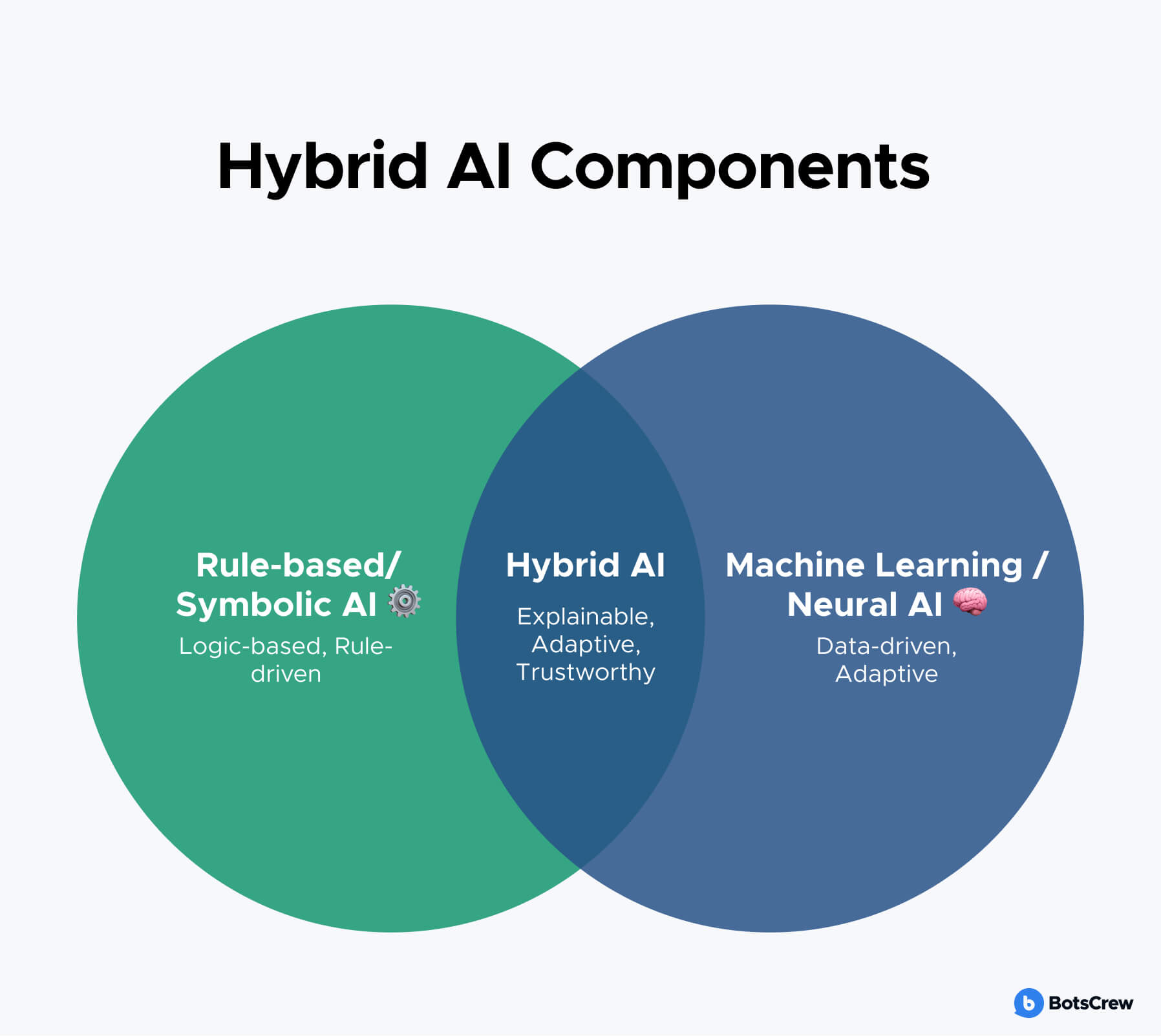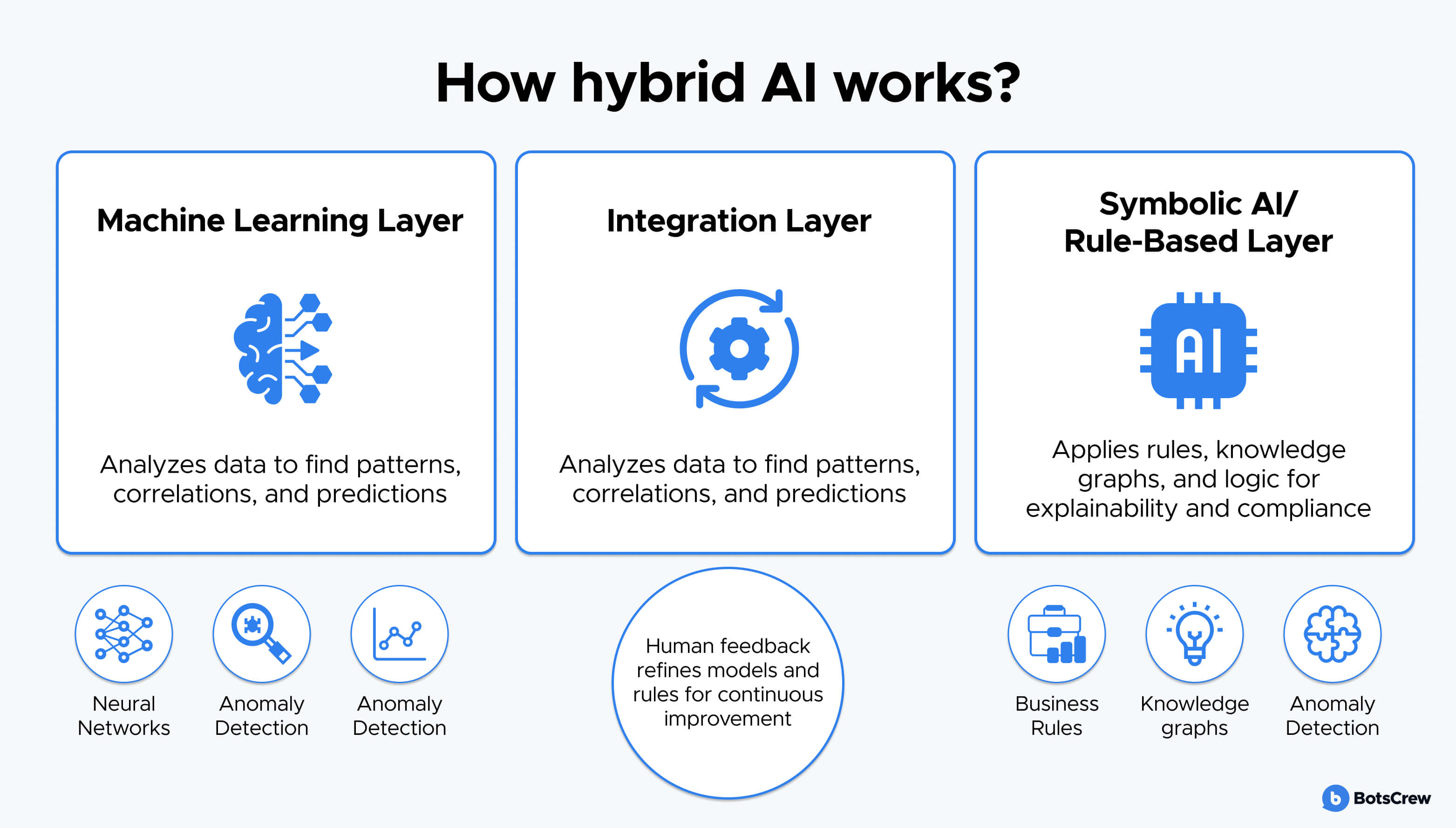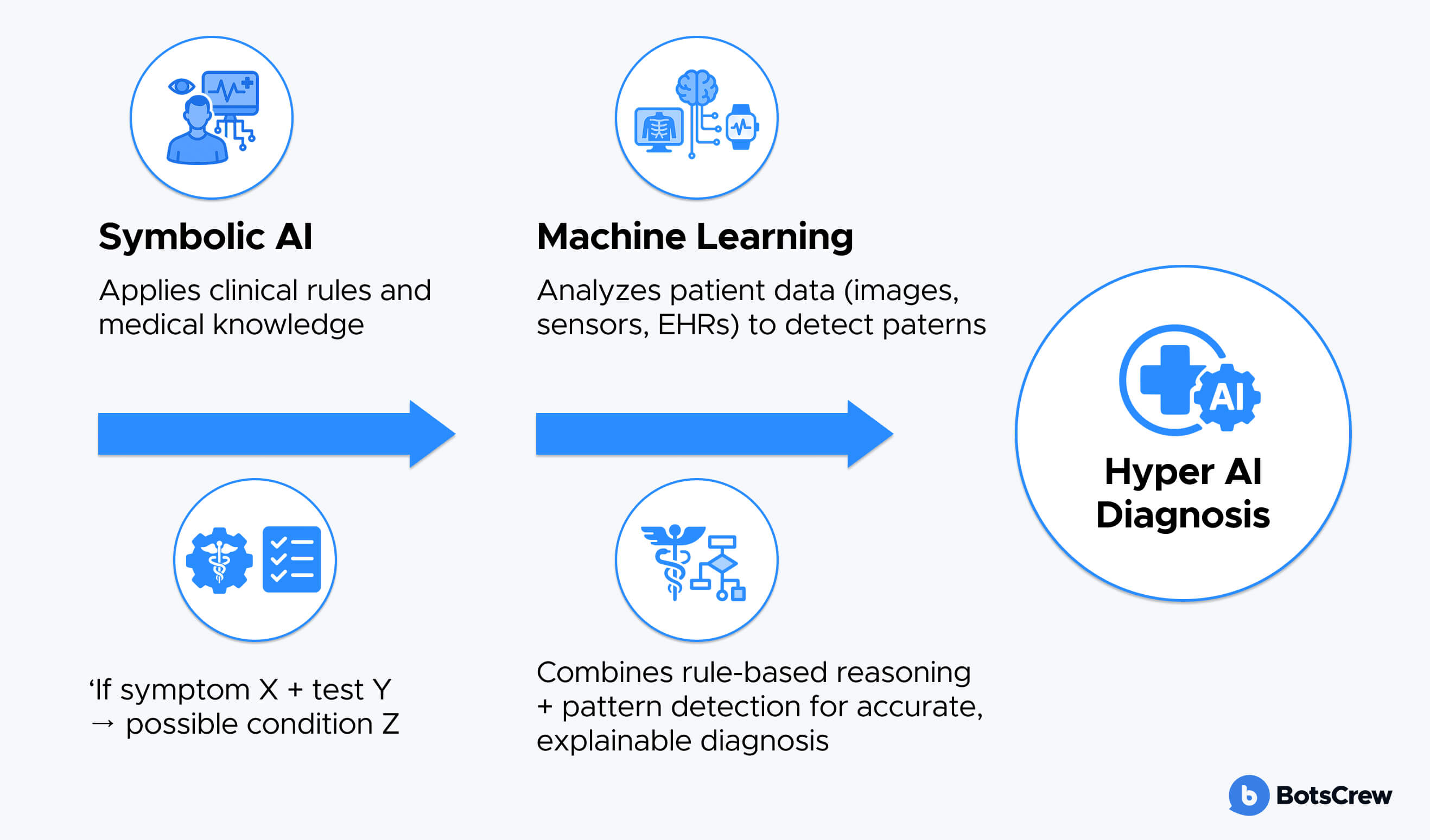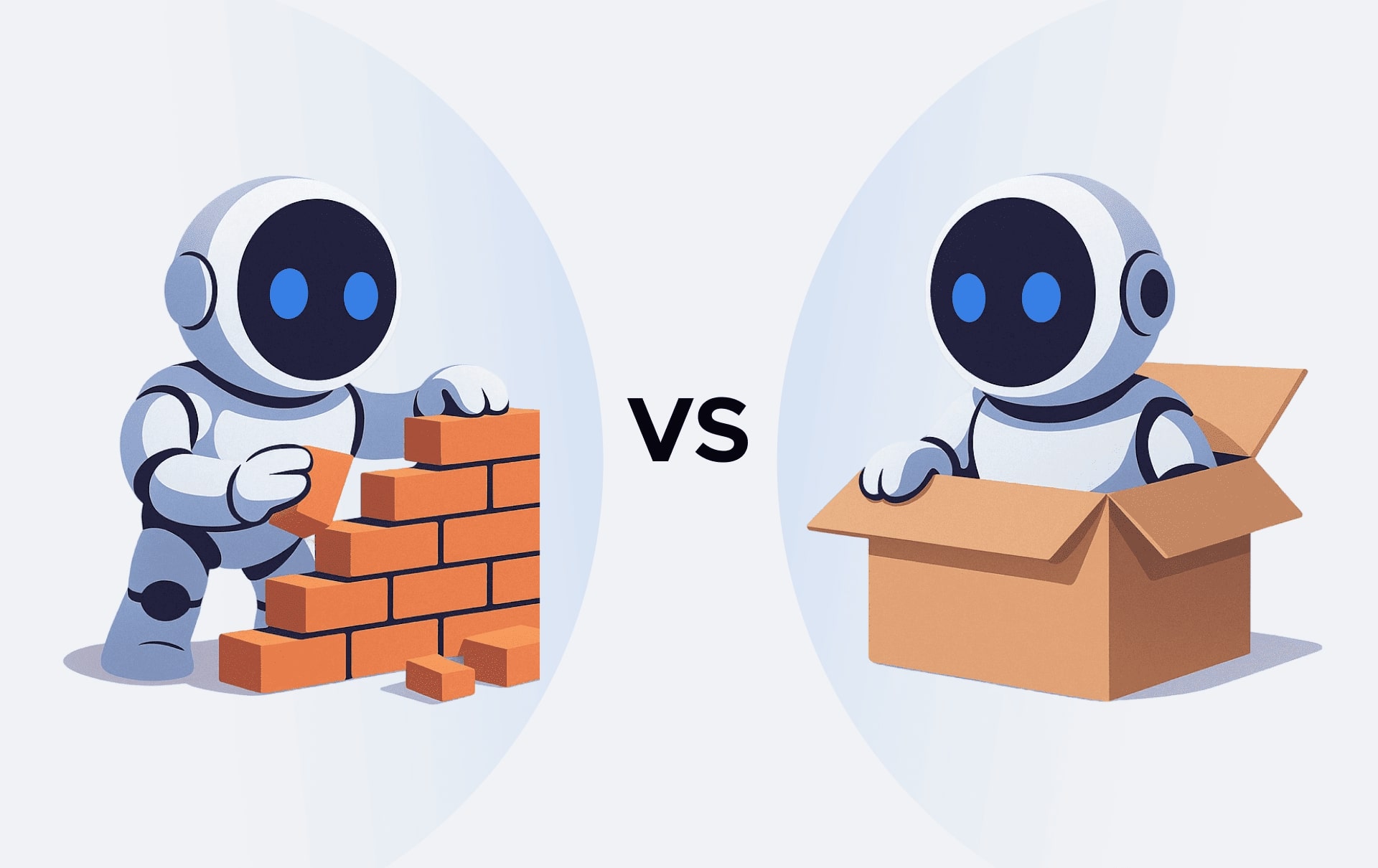What Is Hybrid AI and Why It’s the Future of Enterprise AI
Enterprises today face a growing challenge in AI adoption — how to balance rapid innovation with control, transparency, and trust. Hybrid AI offers the solution by combining the logic and explainability of rule-based systems with the adaptability and intelligence of machine learning, enabling smarter and more reliable enterprise AI.

Enterprises today face a growing dilemma in AI adoption: how to balance innovation with control.
On one hand, machine learning and generative AI models unlock creativity, automation, and new business insights. On the other, they can hallucinate, behave unpredictably, and raise concerns about governance, compliance, and data security.
As AI moves from experimentation to enterprise-wide deployment, businesses need a model that’s not only powerful but also explainable, auditable, and trustworthy. That’s where Hybrid AI comes in.
Hybrid AI combines symbolic reasoning (logic-based, rule-driven systems) with neural learning (data-driven, adaptive systems). It merges the precision of traditional AI with the creativity of modern generative models — creating a new class of enterprise AI that’s both intelligent and responsible.
In this article, we’ll explore what hybrid AI is, what is the hybrid approach to ai implementation, how it works, why it’s becoming essential for enterprises, and how your organization can begin adopting it.
What Is Hybrid AI?
Hybrid AI is an approach that combines multiple types of artificial intelligence techniques — typically symbolic AI (rule-based reasoning) and machine learning (data-driven AI) — to create systems that are more flexible, explainable, and capable of handling complex enterprise tasks.
The Core Components
Hybrid AI operates by integrating:
- Rule-based systems: These rely on predefined rules, logic, and structured data. It’s like having a knowledge base that can perform reasoning and decision-making based on explicit rules and facts.
- Machine learning algorithms: These learn from data, recognize patterns, and generate predictions or classifications in novel situations. ML models adapt based on the input data and don’t require predefined rules to make decisions.
- Sometimes, symbolic AI (knowledge graphs, ontologies) is included for domain expertise, along with feedback mechanisms for ongoing learning

Individually, these paradigms have limitations:
- Rule-based is explainable but rigid and hard to scale.
- ML is flexible and creative but often lacks transparency and control.
💡 Want to see how Hybrid AI could enhance your existing workflows?
Schedule a free AI Discovery Call with our team to map potential hybrid use cases for your business.
How Hybrid AI Works
In a typical Hybrid AI setup:
Machine Learning Layer
The process begins with data being analyzed by machine learning models such as neural networks, random forests, or anomaly detection systems. These models identify hidden correlations, forecast outcomes, or classify patterns from large and often unstructured datasets.
Symbolic or Rule-Based Layer
This layer applies explicit rules, logic statements, or knowledge graphs to interpret, validate, or constrain the outputs from the machine learning models. It adds explainability, transparency, and compliance — ensuring that decisions align with human-defined principles or regulatory standards.
Integration Layer
The integration mechanism allows communication between these two AI types. It translates probabilistic outputs (from ML) into forms understandable by symbolic reasoning systems and, conversely, allows symbolic feedback to adjust model operations.
Feedback and Continuous Learning
Hybrid AI systems often support human-in-the-loop mechanisms. Expert input or user feedback helps refine the symbolic rules or retrain machine learning components, ensuring adaptability and continuous improvement.
- Machine learning extracts and predicts.
- Symbolic AI enforces reasoning and transparency.
- Integration ensures collaboration.
- Feedback enables continual enhancement.

Let’s look at a few more examples:
In a hybrid AI system, these various components work together to complement each other. Here's how they might collaborate:
Combining Symbolic and Machine Learning AI
- Symbolic AI excels at tasks requiring structured reasoning and interpretation of human knowledge, while machine learning excels in handling unstructured data and discovering patterns from large datasets.
- A hybrid system could combine these strengths. For example, symbolic AI could handle tasks like reasoning (e.g., "If A happens, then B will happen") and decision-making based on rules, while machine learning could be used to learn patterns from data that don’t fit easily into rules.
Example: In healthcare, a symbolic AI could handle medical knowledge and rules, while machine learning could process vast amounts of patient data (like images or sensor readings) to detect diseases. The combination enables better diagnostic systems.

Knowledge Representation and Reasoning with Learning
- Hybrid systems can use symbolic AI for representing complex knowledge and reasoning about it. Meanwhile, machine learning can be used to update or modify the knowledge base based on new data or experiences.
Example: In robotics, a hybrid system can combine rule-based decision-making (symbolic) for safety protocols, and deep learning (ML) for understanding and adapting to complex environments.
Cognitive AI: Integrating NLP and Learning
- NLP can help systems understand human language, while machine learning can help the system "learn" language patterns. Together, they can improve tasks such as customer support, chatbots, or language translation.
Example: A hybrid AI-powered virtual assistant can combine pre-programmed knowledge (symbolic AI) and deep learning (to adapt to the user’s conversational style).
Why Enterprises Are Turning to Hybrid AI
Enterprises often face complex, dynamic problems that cannot be solved effectively with a single AI approach. Using hybrid AI—which combines different AI techniques—offers several advantages over relying on just one type of AI. Here’s why an enterprise might choose hybrid AI over a single approach:
1. Handling Complex and Diverse Tasks
Modern business environments involve a wide range of problems, some of which are highly structured and rule-based (e.g., regulatory compliance, financial reporting), while others are more open-ended and data-driven (e.g., customer behavior analysis, image recognition).
By using a combination of symbolic AI (for structured tasks) and machine learning (for unstructured tasks), enterprises can tackle a wider variety of challenges simultaneously. For example, in customer service, the system might use symbolic AI for handling specific queries based on predefined rules, while using machine learning to analyze sentiment and predict customer needs.
2. Maximizing Accuracy and Performance
No single AI approach is perfect for all types of tasks. Machine learning, for instance, excels in recognizing patterns in large datasets but struggles with tasks that require explicit reasoning and logic. Symbolic AI, on the other hand, is great at reasoning but doesn’t handle ambiguity in data well.
Combining both allows enterprises to maximize the strengths of each approach. For example, in fraud detection, machine learning can identify suspicious patterns in transaction data, while symbolic AI can apply business rules and regulatory requirements to ensure that the detection system adheres to legal standards.
3. Better Decision-Making in Uncertainty
Many enterprise scenarios involve uncertainty—where data is incomplete, ambiguous, or noisy. Machine learning can help in finding patterns even when data is imperfect, but it might make errors in complex, edge cases.
By integrating symbolic reasoning with machine learning, enterprises can improve decision-making in uncertain environments. Symbolic AI can provide a layer of structured decision-making based on known rules, while machine learning can adapt to new and unseen data, ensuring that decisions are both flexible and grounded in logic.
4. Faster Adaptation to New Data
Enterprises often need systems that can adapt quickly to new information or changing business conditions (e.g., market shifts, new regulations, emerging competitors).
Machine learning models can learn from new data and adjust over time, while symbolic AI can encode knowledge about the new rules or processes. For example, a hybrid AI system in a financial institution can adjust risk models based on new market conditions while ensuring compliance with regulatory changes.
5. Improved Interpretability and Trust
Many enterprises are concerned with the "black-box" nature of deep learning or machine learning models. These models often lack transparency, which can be problematic in industries like finance, healthcare, or law, where decisions need to be explainable to regulators or customers.
Symbolic AI provides transparency because it uses explicit rules and logic, making decisions easier to trace and explain. This can complement machine learning models, which might otherwise lack interpretability. In this way, hybrid AI offers both the power of data-driven insights and the transparency of rule-based systems.
6. Optimizing Resource Allocation
Certain AI techniques, like deep learning, can be computationally expensive, requiring significant resources for training and inference. On the other hand, symbolic AI approaches might be computationally lighter, especially when the knowledge base and rules are well-defined.
Enterprises can optimize the use of resources by choosing the most suitable AI technique for each task. For example, routine decisions could be handled by symbolic AI, while more complex, data-driven tasks could be handled by machine learning, ensuring that computational resources are used efficiently.
7. Enhanced Problem Solving with Cross-Domain Insights
Enterprises often deal with problems that span multiple domains, like supply chain management, HR, and customer service. Different AI techniques are better suited to different kinds of problems, and a one-size-fits-all approach may not work.
Hybrid systems can combine knowledge from different domains and provide more comprehensive solutions. For example, in supply chain management, symbolic AI could be used for logistical rules, while machine learning models predict demand based on market trends. Together, they create a more efficient, data-driven, and rule-compliant supply chain.
8. Regulatory Compliance and Risk Management
Many industries, such as finance, healthcare, and legal, are heavily regulated and require AI systems that not only make decisions but also explain and justify those decisions in terms of established rules.
Symbolic AI can encode compliance rules (e.g., regulatory requirements) directly into the system, while machine learning can identify patterns or anomalies in vast amounts of data. This ensures that AI-driven decisions are both accurate and compliant with the regulations.
9. Long-Term Scalability and Adaptability
Businesses evolve over time, and what works today might not be sufficient tomorrow. AI systems need to evolve too, to handle new challenges, data, and customer demands.
Hybrid AI provides a flexible foundation that can evolve with changing needs. As new AI techniques emerge, enterprises can integrate them with existing systems. For instance, as new machine learning models are developed, they can be incorporated into the hybrid system, while still benefiting from the stability and reliability of symbolic AI.
In essence, hybrid AI offers a more flexible, robust, and scalable solution for enterprises because it combines the strengths of multiple AI approaches, while mitigating the weaknesses of each. Enterprises choose hybrid AI because it provides better performance, adaptability, and more accurate decision-making across a range of complex, real-world problems that require both structured and unstructured data to be processed effectively.
In industries like healthcare, finance, logistics, and customer service, where multiple types of data and decision-making processes coexist, hybrid AI is often the most effective approach to create systems that can grow, adapt, and provide reliable outcomes.
🧭 Looking to integrate Hybrid AI safely and effectively?
Explore our AI Strategy Consulting services to design an implementation roadmap aligned with your goals.

Real-World Use Cases of Hybrid AI
Hybrid AI has been gaining traction across various industries due to its ability to combine the strengths of multiple AI techniques (like symbolic reasoning, machine learning, and deep learning) to solve complex, real-world problems. Here are some compelling real-world use cases of hybrid AI in action:
Healthcare
Healthcare applications need to analyze diverse and complex data sources, such as patient records, medical images, genomic data, and clinical knowledge.
Hybrid AI Approach:
- Deep Learning: Used for analyzing medical images (e.g., detecting tumors in radiology images, identifying patterns in MRI scans) or understanding genomic sequences.
- Symbolic AI: Encodes medical knowledge, such as diagnosis criteria, treatment protocols, and patient-specific factors (e.g., allergies, age, medical history).
- Machine Learning: Can be used for predictive analytics, like predicting patient outcomes, readmission rates, or potential adverse drug reactions.
Outcome: Hybrid AI can assist doctors by providing more accurate diagnostics (e.g., detecting diseases earlier) and offering personalized treatment recommendations based on both data-driven patterns and expert knowledge.
Finance
Financial institutions need to detect and prevent fraud in real-time, analyzing large volumes of transactional data and historical patterns.
Hybrid AI Approach:
- Machine Learning: Identifies anomalous transactions by learning patterns from historical data (e.g., unusual spending behavior, sudden large transactions).
- Symbolic AI: Implements rules based on regulations (e.g., anti-money laundering rules) and domain knowledge.
- Deep Learning: Used for identifying more subtle patterns or emerging types of fraud that don’t fit previous models.
Outcome: Hybrid AI systems in finance are better at identifying new or evolving fraud tactics while ensuring compliance with regulatory frameworks. This helps banks and financial institutions reduce false positives and improve detection accuracy.
Customer Service
In customer support, AI systems need to handle both structured queries (e.g., account balance, order status) and unstructured conversations (e.g., customer complaints, questions).
Hybrid AI Approach:
- Natural Language Processing (NLP): Used for understanding and processing human language, including context, tone, and intent.
- Symbolic AI: Encodes business rules, FAQs, and knowledge bases for straightforward queries or to follow workflows (e.g., troubleshooting steps).
- Machine Learning: Uses past customer interactions to personalize responses, understand evolving customer preferences, and improve over time.
Outcome: Hybrid AI can provide both automated responses and human-like interactions. For instance, an AI chatbot might answer basic questions (rule-based) but escalate more complex queries to a human representative. It can also continuously learn from new interactions to improve its performance.
Supply Chain
In supply chain management, enterprises need to optimize inventory, predict demand, and automate logistics decisions, all while managing risks and disruptions.
Hybrid AI Approach:
- Machine Learning: Analyzes historical data to predict demand trends, sales forecasts, and potential disruptions in the supply chain.
- Symbolic AI: Encodes business rules (e.g., inventory thresholds, supplier contracts, shipping regulations) and optimization constraints (e.g., cost minimization, delivery deadlines).
- Reinforcement Learning: Used for real-time decision-making in dynamic environments, like adjusting routes or suppliers based on current market conditions or disruptions.
Outcome: Hybrid AI enables companies to better predict demand, reduce waste, and dynamically adjust to changes in supply, demand, and logistics, ultimately lowering costs and improving service levels.
Manufacturing
In manufacturing, AI systems need to monitor and control complex processes (e.g., assembly lines, quality control), while also predicting equipment failures and optimizing production schedules.
Hybrid AI Approach:
- Machine Learning: Predicts machine failures, maintenance needs, or bottlenecks in the production line based on sensor data from equipment.
- Symbolic AI: Uses predefined rules and expert knowledge to monitor quality control, set production schedules, and ensure regulatory compliance.
- Deep Learning: Analyzes visual inspection data to detect defects in products (e.g., identifying scratches, color mismatches).
Outcome: Hybrid AI improves the efficiency, reliability, and quality of manufacturing processes by combining predictive maintenance, real-time quality control, and automated decision-making.
Law
Law firms and corporations use AI to assist in reviewing large volumes of legal documents, ensuring compliance with regulations, and identifying potential risks.
Hybrid AI Approach:
- Natural Language Processing (NLP): Processes legal documents to extract relevant information, such as clauses, dates, and obligations.
- Symbolic AI: Encodes legal rules and regulatory requirements (e.g., contract clauses, legal precedents) to guide document review.
- Machine Learning: Classifies documents based on relevance, detects anomalies, and predicts potential legal risks.
Outcome: Hybrid AI speeds up the legal review process, reduces human error, and ensures better compliance with laws, saving time and costs for legal professionals.
Retail and E-Commerce
In retail, AI is used to personalize the shopping experience, from product recommendations to dynamic pricing and customer service.
Hybrid AI Approach:
- Machine Learning: Used to analyze customer behavior, purchase history, and preferences to recommend products or offer targeted promotions.
- Symbolic AI: Encodes business rules for product categorization, discount strategies, or loyalty programs.
- Natural Language Processing (NLP): Helps understand and respond to customer reviews or inquiries, enabling dynamic adjustments to marketing strategies.
Outcome: Hybrid AI helps retailers offer personalized shopping experiences, improving customer satisfaction and increasing sales through tailored recommendations, promotions, and services.
Hybrid AI vs. Traditional AI Approaches
Hybrid AI is the most versatile and powerful approach, particularly for complex, multi-faceted problems that require both reasoning and learning. It’s ideal when you need to combine structured data processing with unstructured data and make adaptive decisions.
Rule-Based AI is still useful for simple, well-defined tasks where logic is clear and doesn't change frequently, but it’s limited when it comes to handling complex scenarios or large volumes of data.
Deep Learning is highly specialized for tasks that involve unstructured data (like images, audio, and text), but it requires significant computational resources and data to perform well.
Machine Learning is the go-to solution for many structured data tasks, especially when you need to make predictions or classifications based on historical data. It's less resource-intensive than deep learning but lacks the power to handle unstructured data.
Challenges to Consider
Implementing Hybrid AI can bring significant benefits, but it also comes with several challenges that need to be considered to ensure the system works effectively, efficiently, and ethically. Here's a breakdown of the key challenges that organizations should keep in mind when adopting and implementing hybrid AI:
1. Integration Complexity
Hybrid AI involves combining multiple AI techniques (such as symbolic AI, machine learning, deep learning, and reinforcement learning), each with its own data requirements, algorithms, and frameworks.
Integrating these diverse approaches into a cohesive system can be technically complex. It often requires expert knowledge in various domains of AI and might involve reconciling incompatible architectures or programming languages.
Solution: A clear architectural blueprint that defines how each AI model interacts with the others is essential. Standardizing interfaces and leveraging modular frameworks can help.
2. Data Compatibility and Quality
Hybrid AI systems need to process both structured and unstructured data (e.g., databases, sensor data, images, text). Ensuring that all the data can flow seamlessly across different models is a significant challenge.
The quality, consistency, and volume of data can vary across models, and this can affect how well the models work together. Data preprocessing, cleaning, and alignment become even more critical in hybrid systems.
Solution: Use a unified data pipeline that cleans, normalizes, and formats data before it enters the hybrid models. It may also require domain-specific data engineering expertise to ensure the data is compatible with all AI models.
3. Scalability and Resource Requirements
Hybrid AI systems can require significant computational resources, especially if they involve both deep learning (which often requires GPUs) and symbolic AI (which may require substantial processing power for rule-based systems).
As the system scales to handle larger datasets or more complex models, the computational and infrastructure demands increase, potentially leading to higher costs.
Solution: Design the system with scalability in mind from the beginning. Consider cloud-based solutions and distributed computing to handle resource-heavy tasks. Using cloud services like AWS, Google Cloud, or Microsoft Azure can help scale computational needs dynamically.
4. Maintenance and Continuous Learning
Hybrid AI systems require ongoing maintenance and updates to ensure they continue to evolve and improve. Updating one part of the system (e.g., a machine learning model) might affect the behavior of others.
Continuous learning and retraining models can lead to concept drift, where the data distribution changes over time, causing models to become less accurate.
Solution: Implement a monitoring system that tracks performance across all components of the hybrid AI system and provides feedback loops for continuous learning. Use techniques like incremental learning or transfer learning to ensure models adapt to new data over time.
5. Ethical and Bias Concerns
Combining different AI models can potentially amplify biases inherent in the individual components (e.g., biased training data in machine learning models, or limited perspective in rule-based systems).
If the hybrid AI system doesn’t effectively address bias and fairness, it could result in unethical outcomes (e.g., discrimination in hiring, lending, or criminal justice applications).
Solution: Ensure the system is ethically designed by incorporating fairness, accountability, and transparency into the development process. Use techniques like bias detection and regular audits to monitor the system’s behavior and prevent discrimination.
6. Compliance and Regulatory Issues
Depending on the industry, hybrid AI systems may be subject to various regulations (e.g., GDPR in Europe, HIPAA in healthcare, or financial regulations) that govern data usage, transparency, and decision-making.
Regulatory frameworks often struggle to keep up with the rapidly evolving field of AI. This can create uncertainty and potential legal risks if the system doesn't comply with data protection or fairness laws.
Solution: Ensure that hybrid AI systems are designed with compliance in mind, embedding privacy-by-design and transparency features. Work with legal experts to ensure the system meets all applicable regulations.
7. Organizational Readiness and Skill Gaps
Developing and deploying hybrid AI requires a cross-disciplinary team of experts in areas such as machine learning, symbolic reasoning, data engineering, and system integration.
There may be significant skill gaps in your organization, and team members may need to be trained on new tools, frameworks, and approaches to hybrid AI.
Solution: Invest in staff training and recruit specialists who can bridge the gap between different AI fields. Foster a culture of collaboration and knowledge sharing between departments (e.g., data science, IT, and business teams).
Conclusion
Hybrid AI represents the next stage in AI evolution — one that moves beyond raw generation toward governed intelligence. It combines the best of both worlds: the adaptability of neural networks and the precision of symbolic logic.
For enterprises, this means AI systems that are:
- ✅ Smarter
- ✅ Safer
- ✅ More aligned with business objectives
If your organization is exploring large-scale AI transformation, start by assessing your readiness and identifying where hybrid models can deliver immediate, measurable value.
The future of enterprise AI isn’t purely neural or purely symbolic — it’s Hybrid. And the sooner companies embrace this balanced approach, the faster they’ll turn AI from an experimental tool into a core driver of competitive advantage.
⚙️ Not sure where to start?
Our experts can help you evaluate technical feasibility, integration complexity, and compliance risks before implementation.








